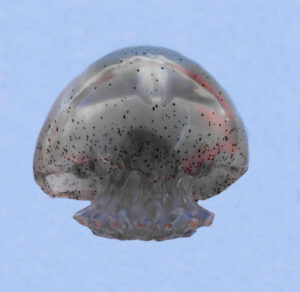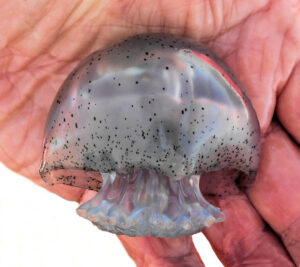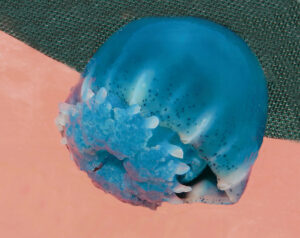Cannonball Jellyfish, Stomolophus meleagris


 Cannonball Jellyfish, Stomolophus meleagris. Jellyfish collected from the surface with a bait net in the Devil’s Curve section of Magdalena Bay, Baja California Sur, October 2019. Size: 8.2 cm (3.2 inches) x 4.9 cm (1.9 inches).
Cannonball Jellyfish, Stomolophus meleagris. Jellyfish collected from the surface with a bait net in the Devil’s Curve section of Magdalena Bay, Baja California Sur, October 2019. Size: 8.2 cm (3.2 inches) x 4.9 cm (1.9 inches).
Phylogeny: The Cannonball Jellyfish, Stomolophus meleagris (Agassiz, 1862), is a member of the Rhizostome Family of Rhizostomatidae Jellyfish. It is also known as the Cabbagehead Jellyfish or the Jelly Ball, and in Mexico as medusa bola de cañón. There presently two recognized species in the genus Stomolophus.
Morphology: The Cannonball Jellyfish is aptly named with a spherical shape that has a very firm somewhat rigid structure. They vary in color depending on geographical location. Those in the Atlantic tend to be milky reddish, yellow or white in color and those from the Pacific are bluish or gray in color. Most have brown specks toward the margin of the bell while some have margins that are completely brown, or brown with whitish specks. Their 16 oral arms are short, complexly branched, and white in color. They possess rhopalia and statocysts that are light sensing organs that allow them determine direction. The Cannonball Jellyfish reach a maximum of have a maximum diameter of 25 cm (10 inches) in diameter, 16 cm (5 inches) in height and between 150 g (5 oz) and 1.4 kg (3 lbs 1 oz) in weight.
Habitat and Distribution: Cannonball Jellyfish are normally found near the surface, but can be found at depths up to 85 m (280 feet), as they are strong nektonic swimmers. Cannonball Jellyfish are found in the tropical and sub-tropical waters of the Eastern Pacific, the Western Atlantic and the Western Pacific Ocean. They are a resident of all Mexican waters of both the Atlantic and Pacific Oceans, where they have been found in dense aggregations at large as 160 km (100 miles) long.
Diet: The Cannonball Jellyfish is a strong open water swimmers that consumes crustacean larvae, planktonic fish eggs, fish larvae, and mollusk larvae. Their nematocysts contain a toxin used to capture small zooplankton.
Predation: The Cannonball Jellyfish are mainly predated on by the Leatherback Sea Turtle, but can also be eaten by various crabs and fish. They have the ability to make rapid deep-water dives to avoid some predators.
Reproduction and Development: Reproduction of the Cannonball Jellyfish occurs both sexually and asexually through an alternation of generations like other schyphozoans. Sexual reproduction involves the release of sperm out of the mouth of one animal and into the mouth of another. The embryo develops quickly in specialized pouches on arms near the mouth and within three to five hours larvae fall to the ocean floor and attach to a substrate. Here, they metamorphosize into a scyphistoma, the sessile polyp form, that catches small passing prey. During the asexual phase of reproduction, the polyp will undergo segmentation and metamorphosize again, becoming a swimming ephyra and eventually turn into adult jellyfish. The Cannonball Jellyfish has a life span of between three and six months.
Human Impact: The Cannonball Jellyfish are harvested commercial with trawl nets for use as a human food. They are sold dried and preserved primarily in Asian countries. For example, in 2012 twenty thousand tons were harvested from the El Golfo de Santa Clara in the northern Sea of Cortez that were valued at $3,500,000. They are not known to sting humans directly however they do possess toxins that can cause cardiac problems including irregular heart rhythms and problems in the myocardial conduction pathways. Contact can also cause both eye and skin irritation.